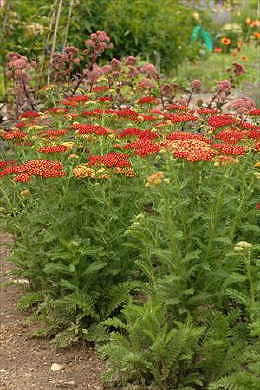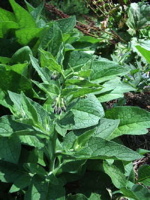10 Companion Plants for the Orchard
(To download this information with diagrams, click here.)
 Companion plants encourage natural processes that benefit overall
health and vitality of fruit trees. This means less work lugging
around sprayers, buying fertilizer, spreading compost and worrying
about pollination. These plants help us do the work and they do
it well.
Companion plants encourage natural processes that benefit overall
health and vitality of fruit trees. This means less work lugging
around sprayers, buying fertilizer, spreading compost and worrying
about pollination. These plants help us do the work and they do
it well.
Companion plants play important roles in the orchard as:
- Living Mulches produce large quantities of organic matter that can be cut back to decompose around tree bases, enriching the soil.
- Dynamic Accumulators have long taproots that bring up minerals from deep subsoil. Cut foliage throughout the season to break down around trees, creating dark nutrient-dense soil.
- Nitrogen-Fixers transform nitrogen from the air to the soil where it can be absorbed by tree roots.
- Beneficial Insect Accumulators contain nectar sought by predatory insects (aka beneficial insects, including braconid wasps, syrphid flies, and lacewings) that feed on fruit-tree pests. BIAs also attract orchard pollinators.
- Pest Confusers have bitter aromas that deter and confuse insect pests from eating fruit.
When planting in your orchard consider:
- Once established, companion plants do not require a lot of care; they will do fine on their own.
- Planting companions in groups, masses or hedges is often more effective than planting individuals. Think nature!
- Plant woody shrubs and beneficial insect accumulators along orchard borders where they can flower and thrive undisturbed out of the way of the mower. Others such as Living Mulches, Dynamic Accumulators and herbaceous Nitrogen Fixers can be placed closer to the trees. Cut them and let the foliage decompose to nourish feeder roots.
Here are our top 10 companions. Don’t limit yourself—there are many more! Where noted, these are available from Fedco Trees (FT), Fedco Seeds (FS) or Fedco Bulbs (FB). Those not offered by Fedco can be found elsewhere, often by the side of the road or in your own backyard.
- Comfrey Symphytum officinale Dynamic Accumulator rich in nitrogen, potassium and calcium when cut to the ground for mulch; makes a mineral-rich foliar spray. Predatory pest habitat. Nearly impossible to eradicate: plant it where you want it forever, 4–15' from tree trunks. (FT)
- Daffodils Narcissus spp. Deter mice and voles from girdling tree trunks. Plant in a tight circle (bulb to bulb) about 12" from tree trunks. (FB)
- Dogwoods Cornus spp. Beneficial Accumulator increases braconid wasp populations to parasitize numerous pests such as apple maggot flies, moths and caterpillars. (FT)
- Horsetail Equisetum arvense Dynamic Accumulator extremely rich in silica. The cream of the crop when it comes to making tea for foliar spray. Promotes strong and healthy cell growth in fruit, considered anti-fungal. Don’t let it get too close to the garden or you’ll never get it out. Often found in the wild.
- Hyssop Hyssopus officinalis Pest Confuser with bitter aroma, long used as a companion plant in gardens and orchards. (FT)
- Chives Allium schoenoprasum Help prevent scab. Make into tea and use as a foliar spray. Groundcover and aromatic Pest Confuser. (FS)
- Siberian Peashrub Caragana arborescens Nitrogen-fixing woody shrub can be planted alone or as a border. Prune it back to the base and use for mulch. (FT)
- Sweet Cicely Myrrhis odorata Beneficial Accumulator provides nectar for adult syrphid flies whose larvae eat huge quantities of aphids. Predatory pest habitat. Will thrive in the shade of mature trees. Start from seed, available in the trade.
- Tansy Tanacetum vulgare Pest Confuser with strong aroma of camphor, deters codling moth and borers. Toxic if eaten. Often found in the wild.
- Yarrow Achillea millefolium Living Mulch rich in copper, nitrogen and phosphorus. Also very beneficial for adding minerals to the compost pile. (FS, FT)

Don’t limit yourself—there are many more! To download this information with diagrams, click here.
